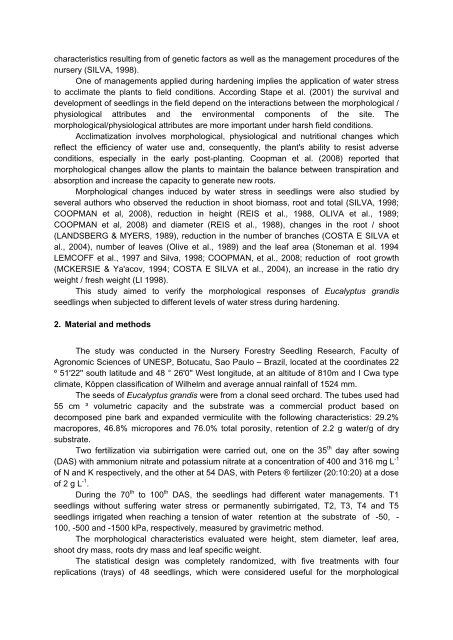poster - International Conference of Agricultural Engineering
poster - International Conference of Agricultural Engineering
poster - International Conference of Agricultural Engineering
You also want an ePaper? Increase the reach of your titles
YUMPU automatically turns print PDFs into web optimized ePapers that Google loves.
characteristics resulting from <strong>of</strong> genetic factors as well as the management procedures <strong>of</strong> the<br />
nursery (SILVA, 1998).<br />
One <strong>of</strong> managements applied during hardening implies the application <strong>of</strong> water stress<br />
to acclimate the plants to field conditions. According Stape et al. (2001) the survival and<br />
development <strong>of</strong> seedlings in the field depend on the interactions between the morphological /<br />
physiological attributes and the environmental components <strong>of</strong> the site. The<br />
morphological/physiological attributes are more important under harsh field conditions.<br />
Acclimatization involves morphological, physiological and nutritional changes which<br />
reflect the efficiency <strong>of</strong> water use and, consequently, the plant's ability to resist adverse<br />
conditions, especially in the early post-planting. Coopman et al. (2008) reported that<br />
morphological changes allow the plants to maintain the balance between transpiration and<br />
absorption and increase the capacity to generate new roots.<br />
Morphological changes induced by water stress in seedlings were also studied by<br />
several authors who observed the reduction in shoot biomass, root and total (SILVA, 1998;<br />
COOPMAN et al, 2008), reduction in height (REIS et al., 1988, OLIVA et al., 1989;<br />
COOPMAN et al, 2008) and diameter (REIS et al., 1988), changes in the root / shoot<br />
(LANDSBERG & MYERS, 1989), reduction in the number <strong>of</strong> branches (COSTA E SILVA et<br />
al., 2004), number <strong>of</strong> leaves (Olive et al., 1989) and the leaf area (Stoneman et al. 1994<br />
LEMCOFF et al., 1997 and Silva, 1998; COOPMAN, et al., 2008; reduction <strong>of</strong> root growth<br />
(MCKERSIE & Ya'acov, 1994; COSTA E SILVA et al., 2004), an increase in the ratio dry<br />
weight / fresh weight (LI 1998).<br />
This study aimed to verify the morphological responses <strong>of</strong> Eucalyptus grandis<br />
seedlings when subjected to different levels <strong>of</strong> water stress during hardening.<br />
2. Material and methods<br />
The study was conducted in the Nursery Forestry Seedling Research, Faculty <strong>of</strong><br />
Agronomic Sciences <strong>of</strong> UNESP, Botucatu, Sao Paulo – Brazil, located at the coordinates 22<br />
º 51'22'' south latitude and 48 ° 26'0'' West longitude, at an altitude <strong>of</strong> 810m and I Cwa type<br />
climate, Köppen classification <strong>of</strong> Wilhelm and average annual rainfall <strong>of</strong> 1524 mm.<br />
The seeds <strong>of</strong> Eucalyptus grandis were from a clonal seed orchard. The tubes used had<br />
55 cm ³ volumetric capacity and the substrate was a commercial product based on<br />
decomposed pine bark and expanded vermiculite with the following characteristics: 29.2%<br />
macropores, 46.8% micropores and 76.0% total porosity, retention <strong>of</strong> 2.2 g water/g <strong>of</strong> dry<br />
substrate.<br />
Two fertilization via subirrigation were carried out, one on the 35 th day after sowing<br />
(DAS) with ammonium nitrate and potassium nitrate at a concentration <strong>of</strong> 400 and 316 mg L -1<br />
<strong>of</strong> N and K respectively, and the other at 54 DAS, with Peters ® fertilizer (20:10:20) at a dose<br />
<strong>of</strong> 2 g L -1 .<br />
During the 70 th to 100 th DAS, the seedlings had different water managements. T1<br />
seedlings without suffering water stress or permanently subirrigated, T2, T3, T4 and T5<br />
seedlings irrigated when reaching a tension <strong>of</strong> water retention at the substrate <strong>of</strong> -50, -<br />
100, -500 and -1500 kPa, respectively, measured by gravimetric method.<br />
The morphological characteristics evaluated were height, stem diameter, leaf area,<br />
shoot dry mass, roots dry mass and leaf specific weight.<br />
The statistical design was completely randomized, with five treatments with four<br />
replications (trays) <strong>of</strong> 48 seedlings, which were considered useful for the morphological

















